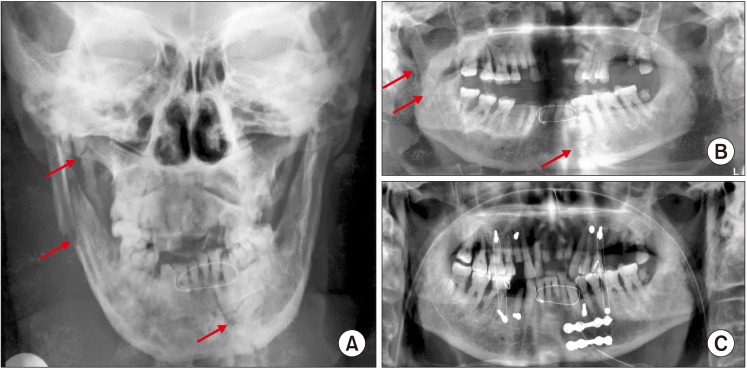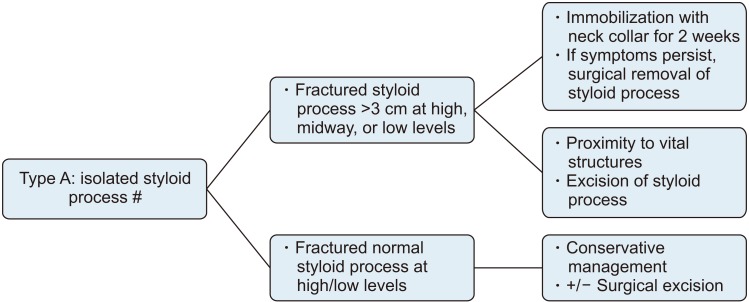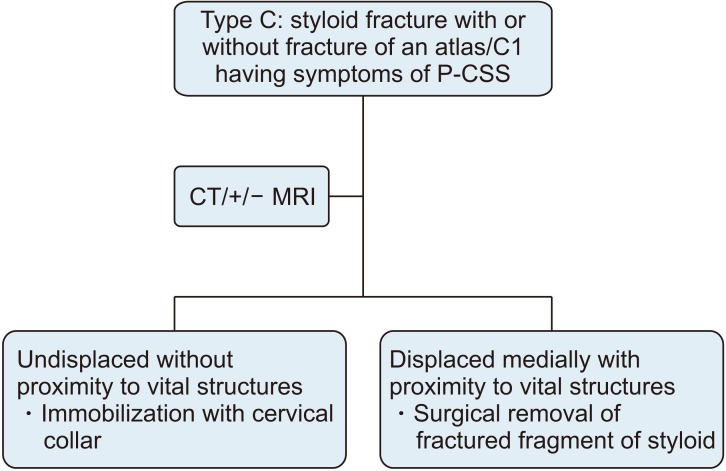J Korean Assoc Oral Maxillofac Surg.
2019 Dec;45(6):302-308. 10.5125/jkaoms.2019.45.6.302.
Cervico-stylo-mandibular complex fracture: a critical review of literature along with a protocol to recognize and proposal of a new classification
- Affiliations
-
- 1Department of Oral and Maxillofacial Surgery, Bapuji Dental College & Hospital, Davangere, India. drvinayakgn@gmail.com
- KMID: 2467181
- DOI: http://doi.org/10.5125/jkaoms.2019.45.6.302
Abstract
- Fractures of the styloid process of the temporal bone may occur with or without an obvious relation to trauma. The incidence of either isolated styloid process fracture or in combination with mandibular fractures is rare, and such occurrences are often misdiagnosed or neglected. A fractured styloid when displaced may impinge on adjacent vital structures, leading to neurological or vascular symptoms that vary according to the anatomical structure compressed. Styloid process fractures associated with atlas/C1 fractures have also been rarely reported in the literature. In this review of literature, the majority of patients was treated conservatively, as few demonstrated the necessity of surgical intervention. There is a definitive need for a protocol to recognize and classify styloid fractures to plan for further treatment. The aim of this review was to achieve a comprehensive understanding of all types of styloid fractures, determine the clinical severity of symptoms, and to consider management and prognosis. In addition, a new classification of cervico-stylo-mandibular fractures is proposed based on important evidence in the literature regarding clinical and radiographic factors that might influence the treatment and prognosis of such fractures.
Figure
Reference
-
1. Mohammad A, Wadhwania A. Bilateral fracture of styloid process. Int J Oral Health Med Res. 2015; 2:42–43.2. Bird PD. Fracture of the styloid process secondary to fracture of the mandible. Br Dent J. 1954; 5:67.3. Haidar A, Kalamchi S. Painful dysphagia due to fracture of the styloid process. Oral Surg Oral Med Oral Pathol. 1980; 49:5–6. PMID: 6927940.
Article4. Raman U, Samraj T. Fracture of the styloid process associated with mandibular fracture. A case report. Int J Oral Maxillofac Surg. 1990; 19:350–351. PMID: 2128312.5. Dubey KN, Bajaj A, Kumar I. Fracture of the styloid process associated with the mandible fracture. Contemp Clin Dent. 2013; 4:116–118. PMID: 23853469.
Article6. Douglas BL, Huebsch RF. Atypical facial neuralgia resulting from fractured styloid process of the temporal bone. Oral Surg Oral Med Oral Pathol. 1953; 6:1199–1201. PMID: 13099836.
Article7. Smith GR, Cherry JE. Traumatic Eagle's syndrome: report of a case and review of the literature. J Oral Maxillofac Surg. 1988; 46:606–609. PMID: 3134531.
Article8. Blythe JN, Matthews NS, Connor S. Eagle's syndrome after fracture of the elongated styloid process. Br J Oral Maxillofac Surg. 2009; 47:233–235. PMID: 18823683.
Article9. Miloro M. Fracture of the styloid process: a case report and review of the literature. J Oral Maxillofac Surg. 1994; 52:1073–1077. PMID: 8089796.
Article10. Domenicucci M, Mancarella C, Dugoni ED, Ciappetta P, Paolo M. Post-traumatic Collet-Sicard syndrome: personal observation and review of the pertinent literature with clinical, radiologic and anatomic considerations. Eur Spine J. 2015; 24:663–670. PMID: 25150715.
Article11. Mnari W, Kilani M, Harrathi K, Maatouk M, Koubaa J, Golli M. An unusual etiology of posttraumatic Collet–Sicard syndrome: a case report. Pan Afr Med J. 2016; 23:143. PMID: 27279968.
Article12. Gayathri G, Elavenil P, Sasikala B, Pathumai M, Krishnakumar Raja VB. ‘Stylo-mandibular complex’ fracture from a maxillofacial surgeon's perspective--review of the literature and proposal of a management algorithm. Int J Oral Maxillofac Surg. 2016; 45:297–303. PMID: 26701324.13. Panneerselvam E, Balasubramaniam S, Sharma AR, Murugadoss P, Chellappazham S, Raja VBK. Fractures of the stylomandibular complex: a prospective study proposing a classification and clinical protocol. J Oral Maxillofac Surg. 2018; 76:1734–1744. PMID: 29550376.14. Martin JS, Marsh JL. Current classification of fractures. Rationale and utility. Radiol Clin North Am. 1997; 35:491–506. PMID: 9167660.15. Gülicher D, Gerlach KL. Failed closed reduction of a bifocal mandibular fracture because of dislocation of the mandibular ramus behind the styloid: case report. Br J Oral Maxillofac Surg. 2000; 38:280–282. PMID: 10922151.
Article16. Raja K, Gopi G, Panneerselvam E, Ramamoorthy J, Doss GT, Sharma AR. Concomitant “ear bleed and styloid fracture”: an unusual complication of impacted mandibular third molar removal. Craniomaxillofac Trauma Reconstr. 2017; 10:212–215. PMID: 28751946.
Article17. Namiki H, Kobayashi T. Fracture of the styloid process in an elderly patient caused by rolling over during sleep: a case report. J Med Cases. 2017; 8:61–62.
Article18. Murtagh RD, Caracciolo JT, Fernandez G. CT findings associated with Eagle syndrome. AJNR Am J Neuroradiol. 2001; 22:1401–1402. PMID: 11498437.19. Stafne EC, Hollinshead WH. Roentgenographic observations on the stylohyoid chain. Oral Surg Oral Med Oral Pathol. 1962; 15:1195–1200. PMID: 13978697.
Article20. Fini G, Gasparini G, Filippini F, Becelli R, Marcotullio D. The long styloid process syndrome or Eagle's syndrome. J Craniomaxillofac Surg. 2000; 28:123–127. PMID: 10958426.
Article21. Koivumäki A, Marinescu-Gava M, Järnstedt J, Sándor GK, Wolff J. Trauma induced eagle syndrome. Int J Oral Maxillofac Surg. 2012; 41:350–353. PMID: 22244077.
Article22. Kermani H, Dehghani N, Aghdashi F, Esmaeelinejad M. Nonsyndromic isolated temporal bone styloid process fracture. Trauma Mon. 2016; 21:e24395. PMID: 27218052.
Article23. Klécha A, Hafian H, Devauchelle B, Lefèvre B. A report of post-traumatic Eagle's syndrome. Int J Oral Maxillofac Surg. 2008; 37:970–972. PMID: 18790603.
Article24. Dettling SD, Morscher MA, Masin JS, Adamczyk MJ. Cranial nerve IX and X impairment after a sports-related Jefferson (C1) fracture in a 16-year-old male: a case report. J Pediatr Orthop. 2013; 33:e23–e27. PMID: 23482276.
- Full Text Links
- Actions
-
Cited
- CITED
-
- Close
- Share
- Similar articles
-
- Overview of Mandibular Condyle Fracture
- Flexion-distraction Injury in Cervico-thoracic Junction: A Case Report
- A Clinical Study of Mandibular Angle Fracture
- Noninvasive Functional therapy of Mandibular Condylar Fracture
- Clinical review of various surgical approaches in the treatment of mandibular condyle fracture





